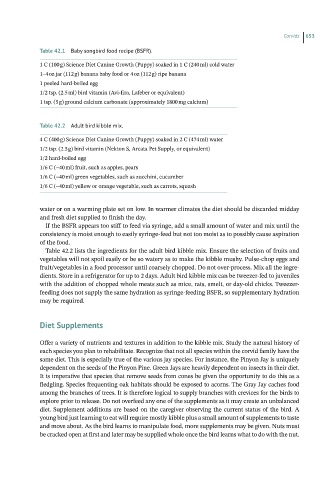Page 652 - Hand rearing birds second
P. 652
Corvids 653
Table42.1 Baby songbird food recipe (BSFR).
1 C (100 g) Science Diet Canine Growth (Puppy) soaked in 1 C (240 ml) cold water
1–4 oz jar (112 g) banana baby food or 4 oz (112 g) ripe banana
1 peeled hard-boiled egg
1/2 tsp. (2.5 ml) bird vitamin (Avi-Era, Lafeber or equivalent)
1 tsp. (5 g) ground calcium carbonate (approximately 1800 mg calcium)
Table42.2 Adult bird kibble mix.
4 C (400 g) Science Diet Canine Growth (Puppy) soaked in 2 C (474 ml) water
1/2 tsp. (2.5 g) bird vitamin (Nekton S, Arcata Pet Supply, or equivalent)
1/2 hard-boiled egg
1/6 C (~40 ml) fruit, such as apples, pears
1/6 C (~40 ml) green vegetables, such as zucchini, cucumber
1/6 C (~40 ml) yellow or orange vegetable, such as carrots, squash
water or on a warming plate set on low. In warmer climates the diet should be discarded midday
and fresh diet supplied to finish the day.
If the BSFR appears too stiff to feed via syringe, add a small amount of water and mix until the
consistency is moist enough to easily syringe-feed but not too moist as to possibly cause aspiration
of the food.
Table 42.2 lists the ingredients for the adult bird kibble mix. Ensure the selection of fruits and
vegetables will not spoil easily or be so watery as to make the kibble mushy. Pulse-chop eggs and
fruit/vegetables in a food processor until coarsely chopped. Do not over-process. Mix all the ingre-
dients. Store in a refrigerator for up to 2 days. Adult bird kibble mix can be tweezer-fed to juveniles
with the addition of chopped whole meats such as mice, rats, smelt, or day-old chicks. Tweezer-
feeding does not supply the same hydration as syringe-feeding BSFR, so supplementary hydration
may be required.
DietSupplements
Offer a variety of nutrients and textures in addition to the kibble mix. Study the natural history of
each species you plan to rehabilitate. Recognize that not all species within the corvid family have the
same diet. This is especially true of the various jay species. For instance, the Pinyon Jay is uniquely
dependent on the seeds of the Pinyon Pine. Green Jays are heavily dependent on insects in their diet.
It is imperative that species that remove seeds from cones be given the opportunity to do this as a
fledgling. Species frequenting oak habitats should be exposed to acorns. The Gray Jay caches food
among the branches of trees. It is therefore logical to supply branches with crevices for the birds to
explore prior to release. Do not overfeed any one of the supplements as it may create an unbalanced
diet. Supplement additions are based on the caregiver observing the current status of the bird. A
young bird just learning to eat will require mostly kibble plus a small amount of supplements to taste
and move about. As the bird learns to manipulate food, more supplements may be given. Nuts must
be cracked open at first and later may be supplied whole once the bird learns what to do with the nut.

